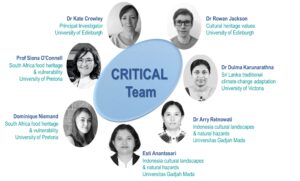Over the next couple of months, the CRITICAL team will post introductory profiles and a self-reflective blog post outlining their position on cultural heritage and risk associated with climate change and natural hazards. In these reflective posts, each team member will consider their key influences, including research traditions, disciplinary training and insights and experiences from field work.

Dr Kate Donovan (was Crowley) is Lecturer in climate change adaptation and disaster risk research and practice at the University of Edinburgh, Scotland. She is was Co-Director of the Edinburgh Climate Change Institute (2021-2023) and a lecturer on the the MSc in Carbon Management. Kate has a background in international development and works to understand risk and adaptation across Scotland and internationally. She has experience managing large, applied research projects including risk modelling and social vulnerability projects.
Dr Rowan Jackson was a Post-Doctoral Research Associate on the CRITICAL research project and a University Teacher in Environmental Sustainability at the University of Edinburgh. His research focuses on evidence of climate change adaptation and resilience over multi-century timescales, particularly in the North Atlantic islands and the Arctic. In recognition of the scale and rate of climate impacts on archaeological sites and landscapes, Rowan also focuses on the role and influence of cultural and natural heritage in shaping community scale adaptation.
Professor Siona O’Connell is the head of a postgraduate programme in Museum and Interdisciplinary Studies at the University of Pretoria. She is well respected for her work on restorative justice in South Africa through research on land restitution. Her research focus falls within three areas, that of Memory Studies, Archive and Museum Studies and Restorative Justice in postcolonial and post-apartheid South Africa. Her work has impacts in several ways, including graduating students and fulfilling conventional academic outputs such as publishing in peer-reviewed journals and books, but equally in creative work and community engagement. She is the founding member of Critical African Studies at UP (castup.ac.za).
Dominique Niemand is a doctoral candidate at the University of Pretoria and currently a visiting research fellow at the University of Basel’s Centre for African Studies. Niemand’s research looks into unknown local histories and tangled food heritages in South Africa. Her research on the CRITICAL research project focuses on the adaptation of the Elandskloof community in the Western Cape of South Africa, in light of past injustices, climate change and food heritage
Dr Dulma Karunarathna is a Post-Doctoral Research Fellow and program coordinator at Centre for Asia-Pacific Initiatives, University of Victoria, Canada and a visiting lecturer at the Postgraduate Institute of Humanities and Social Sciences, University of Peradeniya, Sri Lanka. Exploring cultural diversity is the centre of her career with degrees in Archaeology (PhD, Newcastle University; MPhil and BA, University of Peradeniya). Her research interests lay with Sustainable Built Environment, Heritage and Climate Change, Indigenous knowledge systems, Inclusive history of South Asia, Heritage for Conflict Resolution, Social Archaeology of Gender, Traditional Crafts and Technology.
Dr Arry Retnowati is a lecturer of the Development Geography Department at Universitas Gadjah Mada (UGM), Indonesia. She is expertise in spatial planning focusing on disaster risk reduction/management, cultural landscape and local knowledge related to climatic factors. She is also a researcher at the Research Center for Disaster, working in collaboration with other research centers across UGM. Arry is particularly interested in disaster risk reduction, local knowledge for planning and development upon disaster management, community development towards sustainability and resilience.
Esti Anantasari works as a researcher at the Centre of Excellence of Technological Innovation for Disaster Mitigation (GAMA-InaTEK) and Center for Asian and Pacific Studies Universitas Gadjah Mada, with expertise in anthropology. Her research covers topics on climate change resilience, local initiatives to achieve food sovereignty and disaster risk reduction, particularly in Indonesia. She also focuses on the understanding, capturing and sharing cultural value for climate and disaster management.


